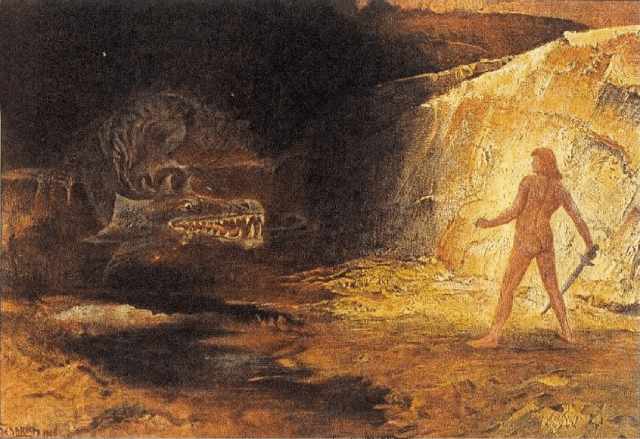Sigurd the Dragon Slayer – Pagan Warrior Turned Valiant Hero
By Daniel Cano.
Stories of valiant warriors often stem from the roots of nobility and purity of soul. However, in The Saga of the Volsungs, we are given a different kind of hero and his lineage. Sigurd the Dragon Slayer’s journey to kill Fafnir is the crux of the legend. It’s what unites him with his Volsung bloodline, performing an awesome feat with many more to come afterward. Yet the story in the text is just one section (Saga 63-65), and only recounts the raw action of the battle. Of course, this is natural since these stories were meant to be orally accounted for to others and the need to recount every small detail would’ve been a cumbersome task for anyone.
William Morris would then take inspiration from the legend and rewrite it for his Victorian audience. As mentioned, the ride to Fafnir’s lair is very short in the saga, shortened so much that it skips the journey and just says he arrived. Morris deals with this section differently and instead treats it as a heroic escapade. The most important thing that Morris does is elaborate more on the heroism of Sigurd. Where it’s implied in the saga, Sigurd throughout the story evokes his bloodline as a Volsung that guides him to kill Fafnir. Responding to Regin’s questioning, Sigurd says that “What needeth hope… When the heart of the Volsungs turns to the light of the Glittering Heath… I shall slay the Foe of the Gods”(Morris 105). Morris elaborates more on the heroism of Sigurd by appealing to his nature as a Volsung, to be brave and face any evil that stands against the Gods. Despite being a pagan figure and worshiper, Morris seems to employ the same kind of rhetoric that would describe knights on a holy quest.
Morris also doesn’t stop at just expanding the ideals of the characters but also amping up the ferocity of their opponents. In the saga, Fafnir’s arrival is only supported by his immense size and poison-blowing which is then promptly stopped by Sigurd with one blow (Saga 63). In the saga, Fafnir is scary because of his nature as a dragon but his quick defeat doesn’t do much to accentuate his ferocity or Sigurd’s triumph. Morris then furthers the description of the battle, appealing to the size of Fafnir. He goes on to describe the strike that would wound Fafnir gushes out blood similar to that of a flowing river, almost drowning Sigurd (Morris 110). But despite the unfavorable situation, Sigurd has “wrathful glittering eyes” (Morris 110) as he cheered his victory over Fafnir. Where in the saga the event is quick and to the point, Morris allows Sigurd to relish his victory, something that a true Viking would do upon defeating such a ferocious foe.






